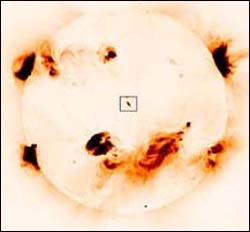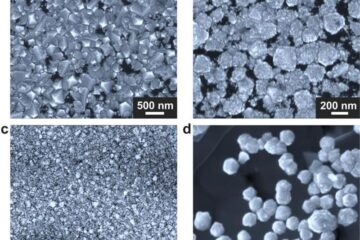Whimpers from the Sun?

A negative image of the Sun showing the active region was taken from Yohkoh data and is provided courtesy of the Solar UK Research Facility.
Solar physicists have observed the smallest ever coronal mass ejection (CME) – a type of explosion where plasma from the Sun is thrown out into space, sometimes striking the Earth and damaging orbiting satellites. The observation has come as a great surprise to scientists and has turned previous ideas up-side-down.
To date studies of these phenomena have focussed on large explosions which are easier to detect and which have massive footprints on the Sun, sometimes covering thousands of millions of square miles. But in a paper published in the May edition of Astronomy and Astrophysics, an international team from the UK, Argentina, Finland, France and Hungary showed that CMEs can also be produced from regions as small as the Earth, around 10,000 miles across. This still may sound large but it is tiny by cosmic standards.
CMEs are believed to be caused by the destabilisation of twisted loops in the Sun’s magnetic field, which contain lots of energy, settling into more stable positions (like a twisted rubber band unwinding suddenly). Until now, the events have been traced back to large areas of magnetic activity on the Sun, but the new observations relate to an area much smaller than anything seen before. However, even though the event was small it was still energetic enough to reach the Earth and amazingly the magnetic field lines were ten times more twisted than is usually seen in the larger areas.
Understanding CMEs and the mechanisms that power them is important because the plasma and accelerated particles they throw into space can damage satellites, cause harm to astronauts and even affect the Earth itself, causing beautiful aurora but also power black outs and problems to radio signals. This is the science of space weather.
Dr Lucie Green of UCL’s Mullard Space Science Laboratory said “Previously coronal mass ejections were thought to be huge, involving massive portions of the Sun’s magnetic field and all the theoretical models are based around this assumption. However, this one was amazing in that it came from a tiny magnetic region on the Sun which would normally have been overlooked in the search for CME source regions. This will be an exciting area for further study.”
Existing models for CMEs are based on the type of large event previously observed and the team cannot yet say how frequent such mini CMEs are or whether they represent a significant part of space weather. The event was so small that is was almost at the limit of what we can see with current instruments. Future missions studying the Sun will be able to ’see’ in much better detail, such as the UK-US-Japanese mission called Solar-B.
The research used data from NASA/ESA’s SOHO spacecraft, NASA’s TRACE satellite and from the now defunct Japanese/US/UK Yohkoh satellite. UK involvement was funded by PPARC.
Media Contact
More Information:
http://www.pparc.ac.ukAll latest news from the category: Physics and Astronomy
This area deals with the fundamental laws and building blocks of nature and how they interact, the properties and the behavior of matter, and research into space and time and their structures.
innovations-report provides in-depth reports and articles on subjects such as astrophysics, laser technologies, nuclear, quantum, particle and solid-state physics, nanotechnologies, planetary research and findings (Mars, Venus) and developments related to the Hubble Telescope.
Newest articles

Making diamonds at ambient pressure
Scientists develop novel liquid metal alloy system to synthesize diamond under moderate conditions. Did you know that 99% of synthetic diamonds are currently produced using high-pressure and high-temperature (HPHT) methods?[2]…

Eruption of mega-magnetic star lights up nearby galaxy
Thanks to ESA satellites, an international team including UNIGE researchers has detected a giant eruption coming from a magnetar, an extremely magnetic neutron star. While ESA’s satellite INTEGRAL was observing…

Solving the riddle of the sphingolipids in coronary artery disease
Weill Cornell Medicine investigators have uncovered a way to unleash in blood vessels the protective effects of a type of fat-related molecule known as a sphingolipid, suggesting a promising new…





















